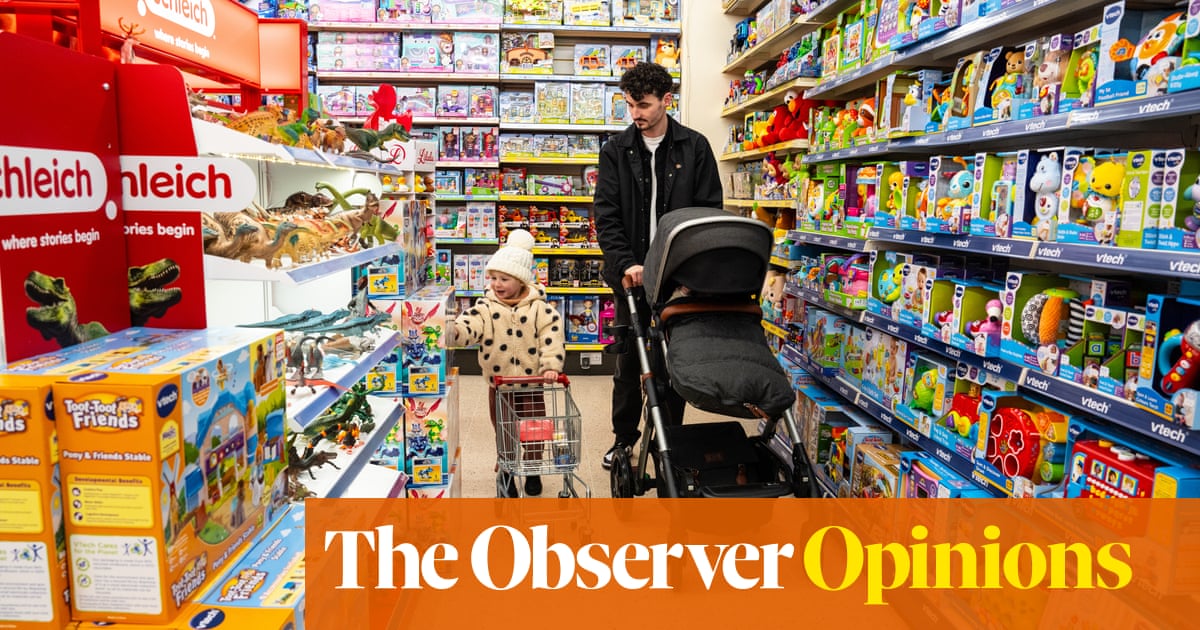
This week I found myself in a large toy shop in a retail park off London’s North Circular. We were looking, in a pleasant panic, for a present for my son’s fourth birthday. His birthdays always hit me in an odd way, a bit like those slaps round the face they have in films to stop the woman screaming. Because: he was born at the beginning of the pandemic and, just as his early developmental stages like sitting up or eating solids worked as a marker of time having passed, of us having survived, so do his birthdays. It is four years, this means, since those tight, hot days of the first Covid lockdown, of sanitiser-cracked hands and the brisk hell of home schooling, and every time the anniversary comes round I find myself having to sit down, take a breath.
Anyway, this toy shop, good God. Do you have any ideas what toys are today? I was not prepared. There are the board games, which include your Guess Who’s and so on, but they are overwhelmed by other games called things like, Who Can Poo On Who and Fart School and Diarrhoea of a CEO and I may be misremembering titles slightly yes, but this was very much the gist, boxes with rabid cartoon characters covered in phlegm and instructions that involve, for eg, burping one’s name.
Then there was the Lego aisle, which boggled me. Did you know, instead of building a little farmhouse or similar, today there are kits, thousands of kits, to build, like, the Eiffel Tower or a studio flat for when the divorce comes through? Prices throughout the shop appear to be decided by lottery. Everything seems either £70 or £3. Art supplies go way beyond felt-tips now – way way beyond; you can barely see a felt-tip from where they go. And there is a whole section beside it for variations on slime. As I fingered the slime with body parts in it, the slime that glowed in the dark, the slime that claimed to have consciousness, I remembered reading a quote from Jean-Paul Sartre, who said sliminess denoted “a type of contaminated morality”, and shuddered a little. It was then that I heard crying. A quiet, chirrupy sort of wail, the cry of a cat or child stuck in a well, and carefully followed the sound to an aisle dedicated to variations on “cute”.
As well as the cuddly toys made of memory foam, designed as therapy pets I believe for a generation who will never have access to mental healthcare on the NHS, there are toys that exist, I think, specifically to bully you. There is a pig, for instance, the dismembered soft head of a pig, and when you press its nose it oinks and laughs at you, not with you, its eyes now red and devil-like. There is a stoned-seeming sloth that repeats your words back to you very slowly as if you are scum. It took some time to track down the weeping – an unidentifiable creature made of rainbow and eyeballs had become trapped behind a shelf, which meant the song it sang when squeezed was stuck on a single, high-pitched note. I freed it by releasing it from the shelf, but did not go so far as to free it by taking it home; there are grades of empathy and I’m just a beginner.
And then there were what a law that’s recently come into effect in California might call the “gendered aisles”. In California large toy stores are now required to have gender-neutral aisles to avoid “reinforcing the traditional gender binary through toys” – I surprise myself regularly, as a feminist, by finding how little I care about this. I mean, I am for, of course, everything for everyone, and I am against, of course, the proliferation of only princessy mops for girls and only murderous dinosaurs for boys, but largely for aesthetic reasons. I suppose I feel, rather than banning, for instance, cleaning kits or baby dolls for little girls, we might be better placed to look at who, in these girls’ homes, does the cleaning, and who puts the babies to bed. If we degender our domestic lives, then won’t the toys surely follow?
Speaking of which, the dolls here are split into three clear categories. There are the sexy dolls, cheerleaders in problematic shoes, there are the sensible dolls, many of whom wear glasses and tartan, and then there are the newborn baby dolls, whose wrinkled flesh and anatomically correct genitals offer an uncanny experience for those merrily trotting through the aisles looking for a present for their own once-baby, trying not to think, too much, about the horrors of time.
Every year around now, as I sit, winded by memory, I wonder why so few of us talk about the pandemic today or pretend it never happened. A while ago I spoke to the disaster expert Lucy Easthope, who wrote in her book, When The Dust Settles: “We are all disaster survivors now.” At early events when she’d read this line, people would tut, or tell her she was being dramatic. “Now, they start to cry.” I guess it’s the unease about where we stand today that makes it harder to contemplate – how do we tell a story like this when we don’t have an ending? I exited the shop with a rainbow wand and a talking orangutan, and a new, useless wisdom.
after newsletter promotion
Email Eva at e.wiseman@observer.co.uk or follow her on X @EvaWiseman